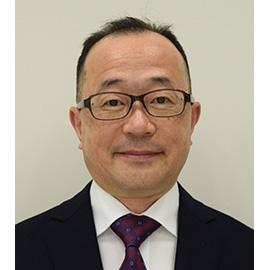For five months from April to September 2023, the Japan Maritime Self-Defense Force conducted Indo-Pacific Deployment 2023 (IPD23). This exercise implemented the guidelines of Japan’s National Defense Strategy, one of the three major security documents released in December 2022. In this paper, I outline the contribution made by IPD23 to achieving the objectives of Japan’s National Defense Strategy. I also discuss the challenges in further promoting these objectives.
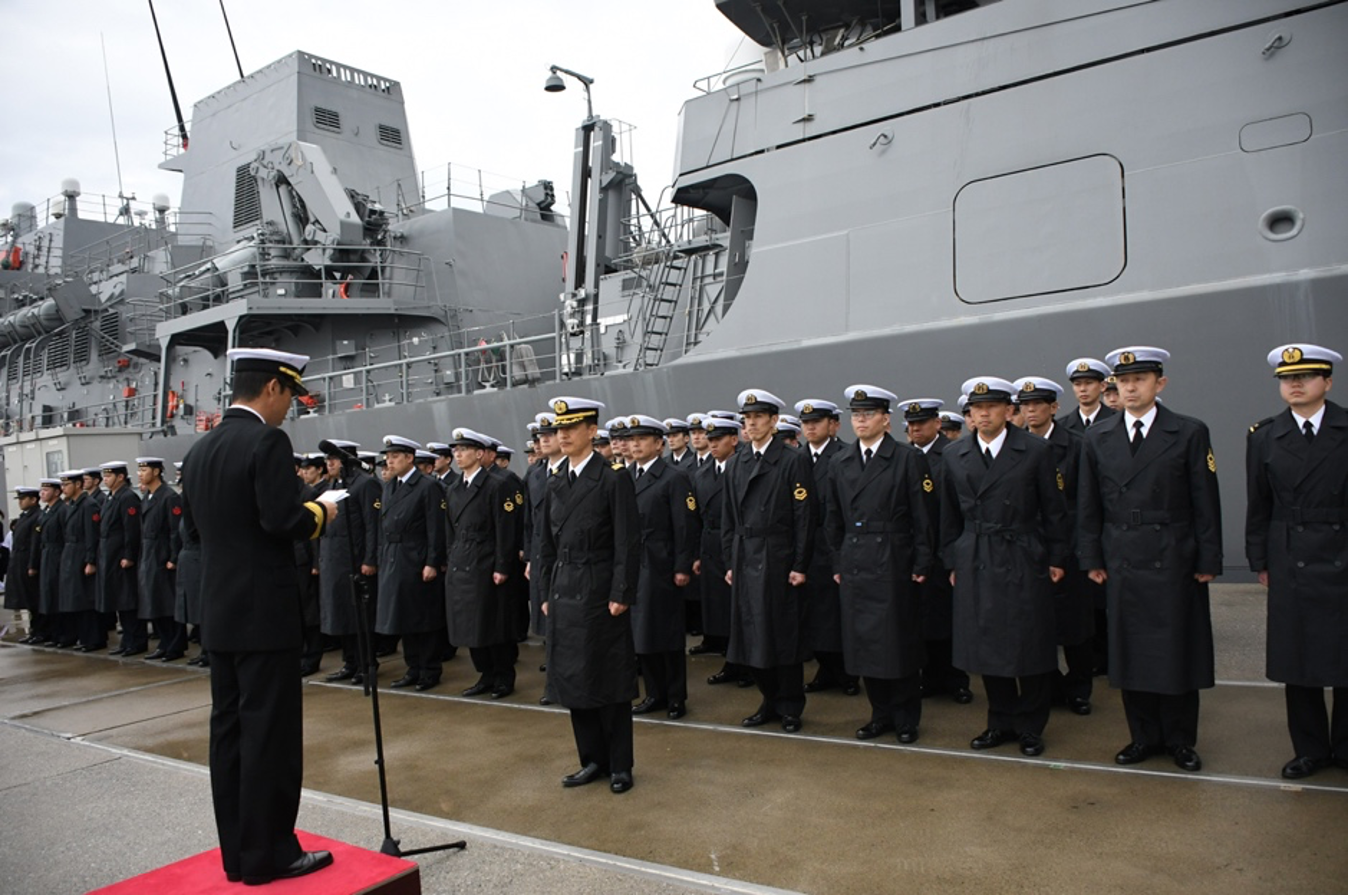
Source: Japan Maritime Self-Defense Force
Guidelines of Japan’s National Defense Strategy and Their Implementation through IPD23
The objectives of IPD23 were “(1) To improve JMSDF tactical capabilities and to strengthen cooperation with partner navies in the Indo-Pacific region through conducting joint exercises” and “(2) To contribute to the peace and stability of the region and to enhance mutual understanding and relationship with partner countries through the deployment.” This was the seventh IPD, the first of which was held in 2017. In total, 27 joint exercises were held under IPD23, including ocean deployment as far as the East China Sea, the South China Sea, and other areas in the South Pacific and Indian Oceans, as well as visits to 17 coastal countries in these areas. IPD23 also included seven main multinational exercises[1]. These represented a concrete approach to achieving the defense objectives outlined in the National Defense Strategy, established in December 2022[2]. IPD23 represented a clear shift in purpose, moving from the stage of convincing countries to embrace the vision of a Free and Open Indo-Pacific (FOIP), regardless of whether or not they share Japan’s values[3], to the stage of collaborating with countries that share its values and deterring countries that do not.
The National Defense Strategy clearly presents Japan’s basic policy on national defense. It replaced the previous National Defense Program Guidelines and represents a significant turning point in Japan’s postwar defense policy[4]. The policy presented under the National Defense Strategy is to “clearly demonstrate the intention that Japan will never tolerate unilateral changes to the status quo by force and such attempts. To this end, Japan must: ... focus on opponents’ capabilities and the ways they prosecute warfare; and, actively adapt to new ways of warfare.”[5] This is the first basic defense policy to explicitly target threats: another major turning point[6]. The document presents three approaches to achieve Japan’s defense objectives: 1) strengthen Japan’s own architecture for national defense, 2) further reinforce joint deterrence and response capability of the Japan-U.S. Alliance, and 3) reinforce collaboration with like-minded countries[7]. The National Defense Strategy includes specific policies for diplomatic efforts, including “promoting robust diplomatic efforts through the promotion such as the vision of a Free and Open Indo-Pacific (FOIP),” together with policies for Japan’s Ministry of Defense and Self‐Defense Forces: “in order to continue to demonstrate the intention and capability to deter unilateral changes to the status quo by force and such attempts and influence opponent’s actions, it is necessary to improve and enhance training and exercises as FDO[8] and Strategic Communications (SC)[9]. with a whole-of-government approach, as well as with our ally and like-minded countries and others.”[10] Given the objective of IPD to conduct exercises in collaboration with like-minded countries, it is only natural that it should incorporate FDO and SC to deter unilateral changes to the status quo by force and attempts to do so[11].
Changes in the Objectives of the Self‐Defense Forces Joint Exercises and IPD23 after the Formulation of the Three Major Security Documents
The following table presents the number of joint exercises undertaken by Japan’s Self‐Defense Forces with the armed forces of foreign countries (from January to December 2023).
Table: Number of joint exercises undertaken by Japan’s Self‐Defense Forces with the armed forces of foreign countries (January to December 2023)
| Joint exercises overseas | Joint exercises in Japan | Total | |
|---|---|---|---|
| Combined exercises | 15 | 24 | 39 |
| Japan Maritime Self-Defense Force | 53 | 56 | 109*1 |
| Japan Air Self-Defense Force | 9 | 33 | 42 |
| Japan Ground Self-Defense Force | 25(14) | 11 | 36(14)*2 |
| Total | 102 | 124 | 226 |
Notes:
・Not including exercises conducted by the Self-Defense Forces alone, but including the antisubmarine exercises by the IPD23 units in the South China Sea.
・Exercises announced as both combined exercises and exercises for each Self-Defense Force are included in combined exercises. Non-combined exercises in which all the Self-Defense Forces participated have been counted for each Self-Defense Force participating.
*1 Of these exercises, 27 or approximately one-quarter were conducted as part of IPD23.
*2 Overseas exercises by the Japan Ground Self-Defense Force include capacity building (shown in parentheses).
Source: Prepared by the author based on Joint Staff Headquarters and Self-Defense Forces websites (as of January 2024)
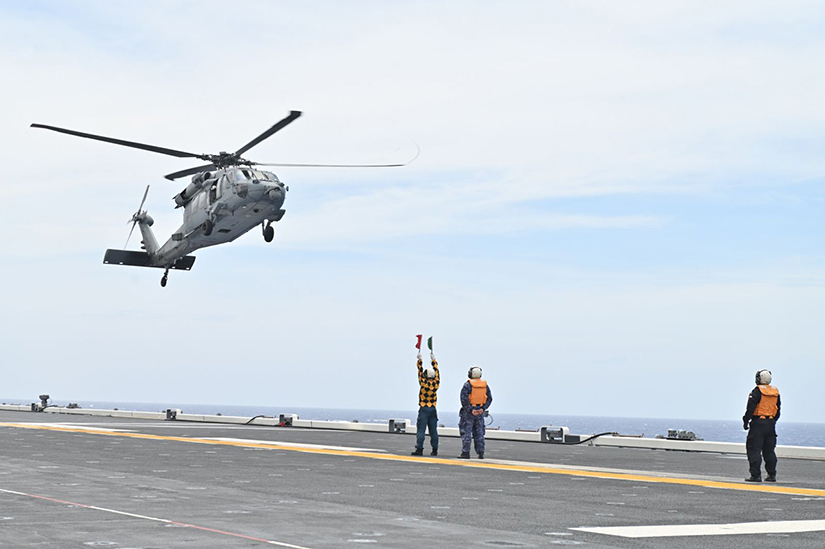
Source: Japan Maritime Self-Defense Force
The number of overseas exercises and domestic joint exercises undertaken by the Japan Self‐Defense Forces with the armed forces of foreign countries has increased year by year, exceeding 200 exercises last year. Around half of these exercises included the United States armed forces. In this context, the Self‐Defense Forces have actively conducted bilateral, and multilateral exercises within Japan, especially with the United States armed forces, in addition to FDO and SC exercises overseas. For example, although combined exercises both overseas and within Japan focus on humanitarian aid and disaster relief (HA/DR), some exercises in Japan, such as Japan-U.S. air and missile defense exercises, Japan-U.S.-South Korea trilateral ballistic missile data sharing exercises, and flight training over Japanese waters, have increased dramatically since fiscal 2022. These exercises serve not only to establish a presence and deterrence against missile launches by North Korea but also contribute to deterring major powers from any actual or attempted unilateral changes to the status quo by force.
In addition to capacity building overseas, the Japan Ground Self-Defense Force is focusing on missile launch exercises, amphibious operation exercises, and special operations training, actively conducting exercises overseas that would be heavily restricted in Japan due to issues of maneuvering range space and regulations. Likewise, the Japan Air Self-Defense Force is increasingly its formation flying exercises with like-minded countries, in addition to Japan-U.S. joint flight exercises in formation over Japanese waters. This implementation of a wide range of exercises with Japan’s allies and many like-minded countries is linked to FDO and SC.
The Japan Maritime Self-Defense Force has maintained its existing rate of overseas exercises and joint exercises in Japan. The content of its exercises under IPD23, however, was qualitatively different from previous years. With the increase in opportunities for visiting countries in the Indo-Pacific region, it conducted no less than 27 joint exercises during deployment, including seven major multilateral exercises. This represents around one-quarter of all the joint and goodwill exercises that the Japan Maritime Self-Defense Force conducted with the armed forces of foreign countries during the year. Moreover, during IPD23, it developed collaboration with like-minded countries and SC to deter actual or attempted unilateral changes to the status quo by force. This included local inspections by the Chief of Staff of the Maritime Self‐Defense Force, as well as the Commander in Chief of the Self Defense Fleet, the major Force User commander of the Maritime Self‐Defense Force (the highest-ranking commander in the Japan Maritime Self-Defense Force who is a Force User: a commander in charge of the unit employment in an emergency).
Specifically, IPD23 featured a visit to Singapore by the Chief of Staff of the Maritime Self‐Defense Force on the occasion of the entry into Singapore of the cutting-edge FFM frigate JS KUMANO [12]. of the IPD Third Surface Unit in May 2023, and participation in the International Maritime Defence Exhibition and Conference IMDEX Asia 2023. Whereas previous overseas travel by commanders of the Self-Defense Fleet had mainly been for specific missions such as inspecting the units involved in counter-piracy operations off the coast of Somalia and in the Gulf of Aden, IPD23 exercises also incorporated inspections of the status of the South China Sea in August and contemporaneous visits to the Philippines by admirals and fleet commanders of Japan, the U.S., Australia, and the Philippines, as part of collaboration between the armed forces of these four nations. This gathering of the supreme commanders (or commanders in charge of the Indo-Pacific region) of the naval forces of these four nations to inspect the deployment of their units in the South China Sea had a massive impact in terms of FDO and SC, as well as the demonstration of presence. Added to this was the local embarkation by the Commander in Chief of Japan’s Self-Defense Fleet on the U.S. aircraft carrier USS Ronald Reagan, then on deployment in the East China Sea, for friendly discussions between the commanders of the Japanese, U.S., and South Korean fleets[13].
The specific content of these exercises by Japan’s Self-Defense Forces marks a clear change from those of previous years. They tangibly manifest the three approaches to achieve Japan’s defense objectives, with a strong consciousness of FDO exercises and other forms of SC, to continue to demonstrate the intention and capability to deter unilateral changes to the status quo by force and such attempts and influence opponent’s actions, in collaboration with allies and like-minded countries.
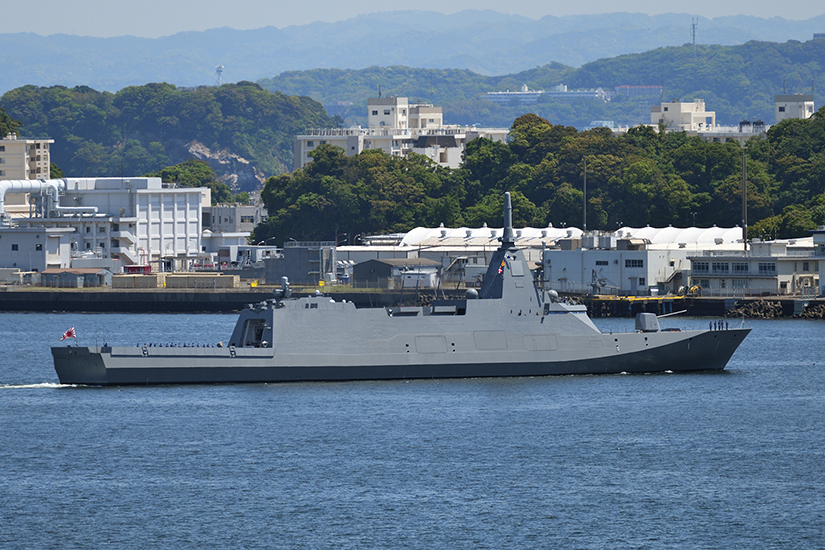
Challenges to Advancing FDO and SC
Japan’s Self-Defense Forces are increasing the number of joint exercises they undertake, both overseas and in Japan, to achieve the objectives of the National Defense Strategy. The content of these exercises, too, advances FDO and SC in line with consistent defense objectives, from policy and strategy down to front-line tactics. Moreover, it is only to be expected that Japan will receive an increasing number of requests to engage in joint exercises from its allies and like-minded countries, given its role in the current security environment. However, given the expected difficulty in increasing the number of Self‐Defense Force personnel going forward, which is also implied by the three major security documents released in December 2022, there is a limit to the number of joint exercises Japan will be able to undertake. In the following section, I describe one scheme with the potential to resolve this issue.
(1) Effective and Efficient Continuation of IPDs through the Utilization of Cutting-Edge FFM Frigates
Japan must scrutinize the requests for joint exercises from allies and like-minded countries together with the optimal joint exercises for advancing FDO and SC, to undertake joint exercises that will be both effective and efficient as approaches to achieving Japan’s national defense objectives. The best way of doing this is through the continuation of IPDs. IPD23 was the first such deployment joined by Japan’s cutting-edge FFM frigate JS KUMANO. FFM Mogami-class frigates feature multi-functionality such as mine warfare capabilities, in addition to the combat capabilities of previous frigates. Meanwhile, these innovative frigates operate with around 90 personnel (Officers and Crews), roughly half of those required by 5,000-ton-class frigates, thanks to personnel-saving measures such as the centralization of data and information on engine status, underwater acoustic waves, and electronics in the onboard Combat Information Center (CIC). The increasing number of these FFM frigates in commission (at least 24 planned) will enable Japan to demonstrate FDO, SC, and its presence more effectively. The continuation of IPDs using these frigates, which require less personnel than previous, more heavily manned frigates, will help Japan resolve the issue described above.
(2) Inspections of Overseas Joint Exercises by Commanders at the Major Command Level (Self-Defense Fleet, etc.)
In the past, Japan has pursued high-level SC through official overseas visits by the Joint Staff Office and the Chiefs of Staff of the Ground, Maritime, and Air Self‐Defense Forces. However, advances in command communications technologies and the development of operational arts, enabling delegation to subordinate units, mean that commanders at the Major Command level can command from anywhere, at least during gray-zone situations and in peacetime. Major Command refers to the main units in a military force, and corresponds to the Ground Component Command, Self-Defense Fleet, and Air Defense Command, for example, in Japan’s Ground, Maritime, and Air Self Defense Forces, respectively. Going forward, it will be vital to bear in mind that the participation in overseas activities and inspections by the commanders of these main units, responsible for directing and managing actual fighting, will, in some cases, advance FDO and SC even more effectively than visits by the Joint Staff Office and the Chiefs of Staff of the Ground, Maritime, and Air Self‐Defense Forces, who are the administrative heads of Japan’s military.
(3) The Touchstone for Integrated Operations and Collaboration between the Ground and Air Self‐Defense Forces and the Japan Coast Guard
During IPD23, the Ground Self‐Defense Force participated primarily in Talisman Saber 2023, a multinational joint exercise organized by the U.S. and Australia, while the Air Self‐Defense Force participated in exercises such as Multi Big-Deck Event, a Japan-U.S.-France joint exercise. The Japan Coast Guard also participated in a Japan-Australia-Kiribati goodwill exercise. The Maritime Self‐Defense Force must further strengthen its coordination with the Ground and Air Self‐Defense Forces and the Japan Coast Guard and endeavor to increase the opportunities for joint and goodwill exercises with the U.S., Australia, India, and countries in ASEAN and Europe. For example, after coordinating the timing between the Self-Defense Forces and the Japan Coast Guard, this should include joint exercises with the armed forces of Australia, the Philippines, and Vietnam commissioned by the Ground Self‐Defense Force outside the IPD time-frame, as well as the participation by Air Self‐Defense Force F-35Bs, not only with Maritime Self‐Defense Force Helicopter Destroyers (DDH) dispatched overseas but also in joint exercises by the U.S., Australia, India, the U.K., and France, together with aircraft carriers and amphibious assault vessels from these countries, even where the Maritime Self‐Defense Force is not participating. These actions will have a significant impact in terms of deterrence and presence. Other possibilities include joint exercises by the Japan Coast Guard with the maritime security authorities of the Philippines, Indonesia, and Brunei Darussalam, as well as the dispatch of the Japan Coast Guard Mobile Cooperation Team (MCT) to the Philippines, Indonesia, Malaysia, Vietnam, Djibouti, and Sri Lanka[14]. Maintaining and expanding this collaboration, together with the more effective and efficient planning of the timing and location of overseas exercises based on coordination between the Joint Staff Office, each Self-Defense Force, and the Japan Coast Guard — rather than independent planning by each — will enable Japan to further enhance its FDO and SC, strengthening Japan’s own nationwide architecture for national defense: one of the objectives of Japan’s defense strategy.
(4) Collaboration with Allies and Like-Minded Countries in Logistics, SC, and Other Areas
Supply, maintenance, and relaxation through entry into the bases and ports of Japan’s allies and like-minded countries are necessary and key operations in overseas training by the Self-Defense Forces, including IPDs. The deployment of SC in collaboration with allies and like-minded countries will also provide a more effective deterrent against authoritarian regimes with few friends that engage in or attempt unilateral changes to the status quo by force. To achieve this, Japan must conclude acquisition and cross-servicing agreements (ACSA), information exchange and protection agreements, and reciprocal access agreements (RAA) with countries that share its values, such as the Philippines, Vietnam, Indonesia, and Singapore, drawing on its experience collaborating with other countries such as Australia and India. These are indispensable to achieve Japan’s National Defense Strategy guidelines, defense objectives, and associated approaches, and must be concluded as soon as possible.
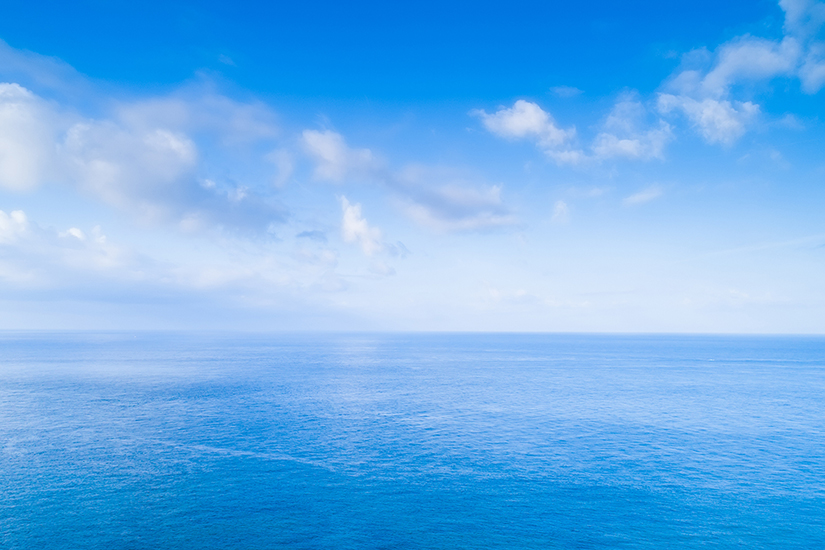
In Place of a Conclusion
IPD23 saw activities in the West (South) Pacific, the East China Sea, the South China Sea, and the Indian Ocean, including the straits that represent key choke points in the Indo-Pacific, based on Japan’s policy under the National Security Strategy to “clearly demonstrate the intention that Japan will never tolerate unilateral changes to the status quo by force and such attempts.” The Japanese forces visited a total of 17 countries and held 27 exercises with like-minded countries that share the same values, centered on the Japan-U.S. Alliance. Japan’s participation in and undertaking of the seven main exercises mentioned above was, of course, important, but the flexible implementation of exercises by the military forces of the countries in each maritime region — a feature of IPD23 — underscored the depth of collaboration. Moreover, the antisubmarine exercises conducted by Maritime Self-Defense Force vessels and submarines in the South China Sea and the gathering of commanders and unit inspections conducted in the deployment of naval units from Japan, the U.S., Australia, and the Philippines in the South China Sea, both part of IPD23, were clearly based on the policies of Japan’s National Security Strategy. Meanwhile, the three major defense documents released in December 2022 indicated no clear pathway to increasing the number of Self-Defense Forces personnel, the nucleus of IPD23. In this paper, I have presented these challenges and one example of how to address them. Going forward, it will be important to monitor how Japan achieves the radical strengthening of its security strategy based on these three major defense documents.
(2024/03/12)
Notes
- 1 Japan Maritime Self-Defense Force “Indo-Pacific Deployment 2023(IPD23).” The units that participated in IPD23 were at least equivalent to one escort flotilla, and were commanded by two Rear Admirals. They included eight warships, four aircraft, and approximately 1,200 personnel, comprising the First Surface Unit (JS IZUMO, JS SAMIDARE, JS SHIRANUI, embarked helicopter x4, and approximately 880 personnel), Second Surface Unit (JS SHIMOKITA, LCAC x2, and approximately 140 personnel), Third Surface Unit (JS KUMANO and approximately 90 personnel), and Submarine Unit (Submarine x1 and approximately 80 personnel). The Japan Ground Self Defense Force also participated in some of the exercises held during IPD23.
The main joint exercises were as follows.- (1) IMDEX Asia 2023
- (2) LIMA 2023
- (3) Pacific Vanguard 2023
- (4) JIMEX 2023
- (5) Pacific Partnership 2023
- (6) Talisman Sabre 2023
- (7) MALABAR 2023
- 2 “National Defense Strategy” (established by the National Security Council and National Cabinet on December 16, 2022) p.9.
- 3 See Shinae Lee “Indo-Pacific Deployment 2022: Japan’s Strategic Communications to the Free and Open Indo-Pacific” (International Information Network Analysis (IINA), September 27, 2022) regarding IPD 2022.
- 4 Ministry of Defense, Defense of Japan 2023, p. 230.
- 5 “National Defense Strategy” p. 9.
- 6 “National Defense Strategy” p. 4.
- 7 “National Defense Strategy” p. 10.
- 8 Flexible deterrent options (FDO) refer to measures aimed at deterrence by conveying the will to engage through methods such as the deployment of units in times of crisis. One example of this was in 1996, when the United States dispatched two carriers to the area near the Taiwan Strait in response to missile tests conducted in the strait by China to obstruct a general election in Taiwan. This action successfully calmed the situation. Takahiro Ishihara, “Strategic Communications and FDO — Consistency and Issues in Foreign Policy Communication —” Japan Maritime Self-Defense Force Staff College Review, July 2016, p. 2. (Japanese)
- 9 Strategic communications refer to “a holistic approach to communication, based on values and interests, that encompasses everything an actor does to achieve objectives, in a contested environment.” NATO Strategic Communications Centre of Excellence, “About Strategic Communications.”
- 10 “National Defense Strategy” p. 15.
- 11 “National Defense Strategy” p. 9.
- 12 The advanced FFM frigate JS KUMANO is the Japan’s second Mogami-class frigate. “FF” stands for “frigate,” while the additional “M” indicates that it is a Mine + Multi-purpose frigate. The numbering of the Mogami-class frigates differs from the three- or four-digit numbering of previous vessels, with the JS MOGAMI given number 1 and the JS KUMANO, which participated in IPD23, number 2. This indicates the Maritime Self‐Defense Force’s intention to clearly differentiate this new class of frigates.
- 13 “Commander in Chief of Self Defense Fleet, JMSDF, Vice Admiral SAITO Akira paid a courtesy visit to Embassy of Japan in the Philippines Deputy Chief of Mission and encouraged IPD23 units,” Self Defense Fleet, August 2023.
- 14 Japan Coast Guard, “Connecting the Oceans,” Coast Guard Report 2022, May 2022. (Japanese)

